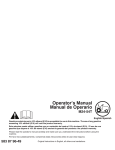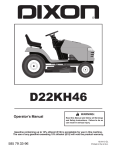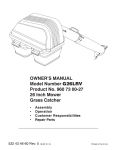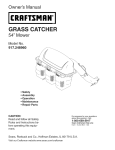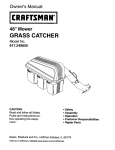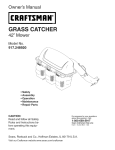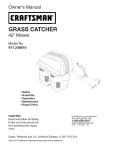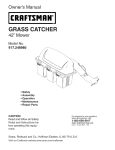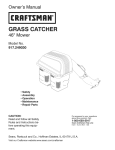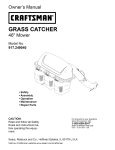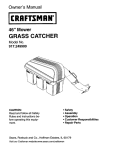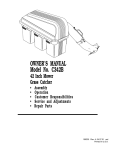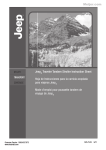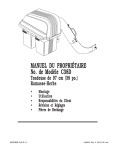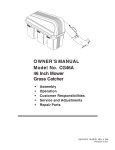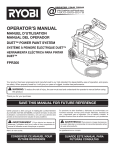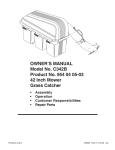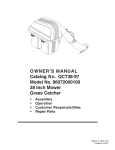Download Craftsman 917.24991 User's Manual
Transcript
Owner’s Manual GRASS CATCHER 26" RIDING MOWER Model No. 917.249910 r. ne ntai t co en em plac d re de en mm co ly a re e on . Us ed mag d or da ke crac en e wh plac Re tly. en qu g fre k ba ec n. Ch ratio rio tie d de ar ject to an we ub ss erlyi r is prop ne ntai less G er IN e mow RNerat WAnot op co un Do G NIN R WA • Español, p. 13 • Safety • Assembly • Operation • Maintenance • Repair Parts CAUTION: Read and follow all Safety Rules and Instructions before op er at ing this equipment. For answers to your questions about this product, Call: 1-800-659-5917 Sears Craftsman Help Line 5 am - 5 pm, Mon - Sat Sears, Roebuck and Co., Hoffman Estates, IL 60179 U.S.A. Visit our Craftsman website:www.sears.com/craftsman 436772 SAFETY RULES Safe Operation Practices for Ride-On Mowers IMPORTANT: THIS CUTTING MACHINE IS CAPABLE OF AMPUTATING HANDS AND FEET AND THROWING OBJECTS. FAILURE TO OBSERVE THE FOLLOWING SAFETY INSTRUCTIONS COULD RESULT IN SERIOUS INJURY OR DEATH. • WARNING: In order to prevent accidental starting when setting up, transporting, adjusting or making repairs, always disconnect spark plug wire and place wire where it cannot contact spark plug. • • WARNING: Do not coast down a hill in neutral, you may lose control of the tractor. WARNING: Tow only the attachments that are recommended by and comply with specifications of the manufacturer of your tractor. Use common sense when towing. Operate only at the lowest possible speed when on a slope. Too heavy of a load, while on a slope, is dangerous. Tires can lose traction with the ground and cause you to lose control of your tractor. II. SLOPE OPERATION Slopes are a major factor related to loss of control and tip-over accidents, which can result in severe injury or death. Operation on all slopes requires extra caution. If you cannot back up the slope or if you feel uneasy on it, do not mow it. • Mow up and down slopes, not across. • Watch for holes, ruts, bumps, rocks, or other hidden objects. Uneven terrain could overturn the machine. Tall grass can hide obstacles. • Choose a low ground speed so that you will not have to stop or shift while on the slope. • Do not mow on wet grass. Tires may lose traction. Always keep the machine in gear when going down slopes. Do not shift to neutral and coast downhill. • Avoid starting, stopping, or turning on a slope. If the tires lose traction, disengage the blades and proceed slowly straight down the slope. • Keep all movement on the slopes slow and gradual. Do not make sudden changes in speed or direction, which could cause the machine to roll over. • Use extra care while operating machine with grass catchers or other attachments; they can affect the stability of the machine. Do no use on steep slopes. • Do not try to stabilize the machine by putting your foot on the ground. • Do not mow near drop-offs, ditches, or embankments. The machine could suddenly roll over if a wheel is over the edge or if the edge caves in. I. GENERAL OPERATION • • • • • • • • • • • • • • • • • Data indicates that operators, age 60 years and above, are involved in a large percentage of riding mowerrelated injuries. These operators should evaluate their ability to operate the riding mower safely enough to protect themselves and others from serious injury. Follow the manufacturer's recommendation for wheel weights or counterweights. Keep machine free of grass , leaves or other debris build-up which can touch hot exhaust/engine parts and burn. Do not allow the mower deck to plow leaves or other debris which can cause build-up to occur. Clean any oil or fuel spillage before operating or storing the machine. Allow machine to cool before storage. Read, understand, and follow all instructions on the machine and in the manual before starting. Do not put hands or feet near rotating parts or under the machine. Keep clear of the discharge opening at all times. Only allow responsible adults, who are familiar with the instructions, to operate the machine. Clear the area of objects such as rocks, toys, wire, etc., which could be picked up and thrown by the blades. Be sure the area is clear of bystanders before operating. Stop machine if anyone enters the area. Never carry passengers. Do not mow in reverse unless absolutely necessary. Always look down and behind before and while backing. Never direct discharged material toward anyone. Avoid discharging material against a wall or obstruction. Material may ricochet back toward the operator. Stop the blades when crossing gravel surfaces. Do not operate machine without the entire grass catcher, discharge guard, or other safety devices in place and working. Slow down before turning. Never leave a running machine unattended. Always turn off blades, set parking brake, stop engine, and remove keys before dismounting. Disengage blades when not mowing. Shut off engine and wait for all parts to come to a complete stop before cleaning the machine, removing the grass catcher, or unclogging the discharge guard. Operate machine only in daylight or good artificial light. Do not operate the machine while under the influence of alcohol or drugs. Watch for traffic when operating near or crossing roadways. Use extra care when loading or unloading the machine into a trailer or truck. Always wear eye protection when operating machine. III. CHILDREN 2 Tragic accidents can occur if the operator is not alert to the presence of children. Children are often attracted to the machine and the mowing activity. Never assume that children will remain where you last saw them. • Keep children out of the mowing area and in the watchful care of a responsible adult other than the operator. • Be alert and turn machine off if a child enters the area. • Before and while backing, look behind and down for small children. • Never carry children, even with the blades shut off. They may fall off and be seriously injured or interfere with safe machine operation. Children who have been given rides in the past may suddenly appear in the mowing area for another ride and be run over or backed over by the machine. • Never allow children to operate the machine. • Use extra care when approaching blind corners, shrubs, trees, or other objects that may block your view of a child. SAFETY RULES Safe Operation Practices for Ride-On Mowers IV. TOWING • • • • • • Tow only with a machine that has a hitch designed for towing. Do not attach towed equipment except at the hitch point. Follow the manufacturer's recommendation for weight limits for towed equipment and towing on slopes. Never allow children or others in or on towed equipment. On slopes, the weight of the towed equipment may cause loss of traction and loss of control. Travel slowly and allow extra distance to stop. • • • • V. SERVICE • SAFE HANDLING OF GASOLINE To avoid personal injury or property damage, use extreme care in handling gasoline. Gasoline is extremely flammable and the vapors are explosive. • Extinguish all cigarettes, cigars, pipes, and other sources of ignition. • Use only approved gasoline container. • Never remove gas cap or add fuel with the engine running. Allow engine to cool before refueling. • Never fuel the machine indoors. • Never store the machine or fuel container where there is an open flame, spark, or pilot light such as on a water heater or other appliances. • Never fill containers inside a vehicle or on a truck or trailer bed with plastic liner. Always place containers on the ground away from your vehicle when filling. • Remove gas-powered equipment from the truck or trailer and refuel it on the ground. If this is not possible, then refuel such equipment with a portable container, rather than from a gasoline dispenser nozzle. • Keep the nozzle in contact with the rim of the fuel tank or container opening at all times until fueling is complete. Do not use a nozzle lock-open device. • If fuel is spilled on clothing, change clothing immediately. • Never overfill fuel tank. Replace gas cap and tighten securely. GENERAL SERVICE • Never operate machine in a closed are. • Keep all nuts and bolts tight to be sure the equipment is in safe working condition. • Never tamper with safety devices. Check their proper operation regularly. • Keep machine free of grass, leaves, or other debris build-up. Clean oil or fuel spillage and remove any fuel-soaked debris. Allow machine to cool before • • • • • • • • • • • • • storing. If you strike a foreign object, stop and inspect the machine. Repair, if necessary, before restarting. Never make any adjustments or repairs with the engine running. Check grass catcher components and the discharge guard frequently and replace with manufacturer's recommended parts, when necessary. Mower blades are sharp. Wrap the blade or wear gloves, and use extra caution when servicing them. Check brake operation frequently. Adjust and service as required. Maintain or replace safety and instruction labels, as necessary. Be sure the area is clear of bystanders before operating. Stop machine if anyone enters the area. Never carry passengers. Do not mow in reverse unless absolutely necessary. Always look down and behind before and while backing. Never carry children, even with the blades shut off. They may fall off and be seriously injured or interfere with safe machine operation. Children who have been given rides in the past may suddenly appear in the mowing area for another ride and be run over or backed over by the machine. Keep children out of the mowing area and in the watchful care of a responsible adult other than the operator. Be alert and turn machine off if a child enters the area. Before and while backing, look behind and down for small children. Mow up and down slopes (15° Max), not across. Be alert and turn machine off if a child enters the area. Choose a low ground speed so that you will not have to stop or shift while on the slope. Avoid starting, stopping, or turning on a slope. If the tires lose traction, disengage the blades and proceed slowly straight down the slope. If machine stops while going uphill, disengage blades, shift into reverse and back down slowly. Do not turn on slopes unless necessary, and then, turn slowly and gradually downhill, if possible. SAVE THESE INSTRUCTIONS TABLE OF CONTENTS SAFETY RULES ................................................................... 2-3 CARTON CONTENTS ............................................................. 4 ASSEMBLY ........................................................................... 5-9 OPERATION .......................................................................... 10 MAINTENANCE ..................................................................... 11 STORAGE .............................................................................. 11 WARRANTY........................................................................... 11 REPAIR PARTS ..................................................................... 12 3 KNOW YOUR GRASS CATCHER READ THIS OWNER'S MANUAL AND SAFETY RULES BEFORE ASSEMBLING OR OPERATING YOUR GRASS CATCHER. Compare the illustrations with the carton contents to familiarize yourself with the parts before starting the assembly. Study the operating instructions and safety precautions thoroughly to insure proper functioning of your Grass Catcher and to prevent injury to yourself and others. Save this manual for future reference. The operation of any riding mower can result in foreign objects thrown into the eyes, which can result in severe eye damage. Always wear safety glasses or eye shields while operating your riding mower or performing any adjustments or repairs. We recommend a wide vision safety mask over spectacles or standard safety glasses. COMPLETE BAGGER MUST BE IN PLACE BEFORE OPERATING MOWER UNPACKING INSTRUCTIONS CARTON CONTENTS: • (2) Containers (1) Upper Chute (1) Lower Chute (1) Blade • Remove all parts and packing materials from carton. Check carton contents against list. Be sure all parts are there. PARTS IDENTIFICATION SUPPORT ASSEMBLY COVER (1) Support Assembly (1) Cover Assembly (1) Counterweight (1) Counterweight hardware (1) Drawbar (1) Deflector Guard (1) Deflector Guard Hardware (1) #7 Drill Bit BLADE FULL BAG INDICATOR DRAWBAR er. ntain t co men ce pla d re de en mm co ly a re e on . Us ed mag d or da ke crac en ce wh pla Re tly. en qu g fre k ba ec n. Ch ratio rio tie d de ar t to LOWER CHUTE ATTACHING STRAPS an we jec ub ss erlyi er is prop ntain s co les G er IN e mow RNerat WAnot op un Do COUNTERWEIGHT G NIN R WA UPPER CHUTE GRASS CATCHER CONTAINERS CHUTE LATCH DEFLECTOR GUARD LOWER CHUTE COUNTERWEIGHT HARDWARE NOTE: When right hand (R.H.) and left hand (L.H.) are mentioned in this manual, it means when you are seated on the riding mower, in the operator's position. CAUTION: BEFORE ASSEMBLING GRASS CATCHER TO RIDING MOWER: • Depress clutch/brake pedal fully and set parking brake. • Place gearshift/motion control lever in "NEUTRAL" position. • Place attachment clutch in "DISENGAGED" position. • Turn ignition key "OFF" and remove key. • Make sure the blade and all moving parts have completely stopped. • Disconnect spark plug wire from plug and place where it cannot come in contact with plug. 4 ASSEMBLY 1 2 REAR DRAWBAR (See Fig. 1A, 1B) REAR MOUNTING BRACKET (See Fig. 2A and 2B) NOTE: Your new drawbar already has four (4) shoulder bolts installed. Simply hang the mounting bracket on the bolts. 1. Remove existing drawbar by removing four screws. Insert flat screwdriver to remove bumper from engine plate. Lift up and pull rearward. SHOULDER BOLTS SUPPORT ASSEMBLY DRAWBAR Fig. 2A ENGINE PLATE TO REMOVE THE SUPPORT ASSEMBLY (See Fig. 2B) 1. Pull outward on the stop bracket enough to allow support assembly to be lifted up and away from drawbar. Fig. 1A PULL OUT ON STOP BRACKET TO REMOVE SUPPORT ASSEMBLY 2. Install new drawbar by replacing screws removed in step 1. DRAWBAR Fig. 2B Fig. 1B 5 3 4 MOUNTING COVER ASSEMBLY TO SUPPORT ASSEMBLY (See Fig. 3) CONTAINER MOUNTING (See Fig. 4) 1. Install one container to left side first. Install other container to right side. NOTE: Left edge of right container should always overlap right edge of left container at center support. 2. Close cover and lock latch over center support tube. To lock and release latch, pull back on latch handle. NOTE: For ease of assembly, you may wish to obtain the assistance of another person for mounting cover assembly to riding mower. 1. Lift and rotate cover to align cover bracket with support assembly. 2. Slide cover assembly down onto the support assembly. COVER LATCH HANDLE SUPPORT ASSEMBLY COVER ASSEMBLY CENTER SUPPORT TUBE CONTAINER HANDLE Fig. 4 Fig. 3 6 5 6 INSTALL DEFLECTOR GUARD (See Fig. 5) LOWER CHUTE (See Fig. 6) 1. Raise and hold deflector and metal shield in upright position. 2. Place slot in lower chute over mounting tab on mower and position lower chute over mower opening as shown. 3. Hook rear latch into flange hole on back of mower. 4. Hook front latch into tab hole on front of mower. 1. Using the deflector guard as a template, hold deflector guard on the top of the deflector aligning edge with the holes with bottom of writing and angled end with the rear of the deflector as pictured. 2. Mark locations of (4) holes and drill using supplied #7 drill bit. 3. Insert screws from bottom through deflector and guard, place washer and then acorn nut on top of guard. Tighten with a screw driver and 3/8 wrench. CAUTION: Do not remove deflector shield from mower. Raise and hold shield when attaching lower chute and allow it to rest on chute while in operation. CAUTION: When using mower with out bagging attachment and with the blade supplied with this kit, the deflector guard must be installed. DEFLECTOR SHIELD DEFLECTOR SHIELD ACORN NUT WASHER TAB SCREW FRONT LATCH DEFLECTOR GUARD Fig. 5 REAR LATCH Fig. 6 7 7 8 UPPER CHUTE (See Fig. 7A and 7B) 1. Lower mower to its lowest cutting position. 2. Assemble upper chute by inserting curved end into hole in back of cover. TIP: Holding upper chute as shown and twisting while installing in cover will help keep the rubber seal in place. NOTE: Handle carefully so as not to damage full bag indicator. BLADE REMOVAL/REPLACEMENT (See Fig. 8) 1. Raise mower to highest position to allow access to blade. NOTE: Protect your hands with gloves and/or wrap blade with heavy cloth. 2. Remove blade bolt by turning counterclockwise. 3. Install new blade with stamped "GRASS SIDE" facing downward. UPPER CHUTE COVER MANDREL ASSEMBLY BLADE r. ine nta en t co em lac ed rep nd me om ly a rec e on d. Us ge ma d or da cke cra en ce wh pla tly. Re en qu g fre k ba ec . Ch ion rat rio tie BLADE BOLT (SPECIAL) d de ar t to an we jec ub iss rly pe r is pro ine nta s co les r un G we IN mo RNerate WAnot op Do STAR G NIN R WA CENTER HOLE Fig. 8 IMPORTANT: To ensure proper assembly, center hole in blade must align with star on mandrel assembly. Fig. 7A 4. Install and tighten blade bolt securely (45-55 Ft. Lbs.). 3. Push in and turn upper chute until it is in line with lower chute. 4. Align the bosses on lower chute with alignment slots on upper chute and slide together. 5. Secure with rubber latch by hooking hole in latch over latch pin. COVER IMPORTANT: Special blade bolt is heat treated. FULL BAG INDICATOR UPPER CHUTE HANDLE er. tain t con en em lac ed rep nd me om ly a rec e on d. Us ge ma cke d or da cra en ce wh pla tly. Re en qu g fre LATCH PIN ba eck . Ch tion tier iora d de ar ct to an we bje ssu rlyi pe er is pro tain s con les r un NG we NIerate mo t op WAR no Do RUBBER LATCH NG NI WAR LOWER CHUTE ALIGNMENT SLOT BOSSES Fig. 7B 8 9 10 LEVEL MOWER DECK COUNTERWEIGHT (See Fig. 9) 1. Lower mower to lowest position to allow access to front axle. 2. Turn steering wheel all the way to the right, for access to left side of axle 3. With extension and socket, insert bolt, lock washer, and washer through hole in axle. NOTE: Insert hardware from rear of axle. 4. Hold counterweight up to axle and start threading bolt. 5. Repeat steps 2-3 from right hand side. IMPORTANT: Torque bolts until tight. Ensure deck is properly leveled for best mower performance. See your riding mower owner's manual for instructions. COUNTERWEIGHT LOCKWASHER WASHER Fig. 9 9 BOLT OPERATION TIPS FOR IMPROVED BAGGING OPERATION: • Your bagger is equipped with a full bagger indicator. Movement of the wheel increases as the bags fill. The wheel will be spinning fastest just before the bags fill completely. When the wheel stops, it indicates that the bags are full and the chutes have become clogged. NOTE: To help prevent clogging of chutes, check/empty bags when the wheel is spinning fast. Experience will teach you the best time to empty the bags. Care should be taken not to damage the parts and that the wheel spins freely at the beginning of each use. • If the grass catcher fails to pick up cut grass or leaves, it is an indication that clogging has occurred in the system or that the grass catcher containers are full. Usually this is indicated by the stopped movement of the full bagger indicator. a. Disengage blade, shift into neutral, engage the parking brake and stop the engine. - Unlatch and raise cover. - Slide out containers and dispose of clippings. - Replace containers, close cover, and latch. b. Unlatch chutes and check for clogging. - Remove all debris in chutes. - Reassemble and latch chutes c. Check to insure full bagger indicator has not become clogged. - The air passage hole must be clear of debris. Gently insert a small twig or wire into passageway to clear. Follow the mower operation instructions in your riding mower owner's manual. When operating your grass catcher on a lawn where grass and leaf bagging equipment has not been used, you are picking up thatch and debris that has accumulated for long periods of time. The amount collected and the total time of operation may be greater than you will experience with regular use of your grass catcher. • Always run throttle at full speed when bagging. • Select a gear low enough to give good mower cutting performance, good quality cut and good bagging performance. NOTE: It may be necessary to overlap width of cut to suit your conditions. • If grass is extremely tall, it should be mowed twice. The first time relatively high, the second time to desired height. • Use left hand side of mower for trimming. • Plastic trash bags can be inserted inside grass catcher containers for ease of debris disposal. To remove the plastic trash bags when full: a. Disengage blades, shift into neutral, engage the parking brake and stop the engine. b. Unlatch and raise cover. c. Remove one container at a time by grasping container handles and pulling toward the rear, off of the tube rails. d. With the container resting on the ground, close and secure the top of the plastic lawn bag. e. Tip the container on its side and slide the filled bag from the container. f. Install a new plastic lawn bag with the edges of the bag draped over upper lip of the container. g. Repeat for other containers. h. Reinstall containers making sure right container overlaps left container at center supports. j. Close cover and secure latches over center support tubes. • Avoid cutting wet grass or in the morning while the dew is still heavy. Grass clippings collected under these conditions tend to be sticky and adhere to the walls of the flow path causing clogging. CAUTION • Do not operate mower with grass catcher partially installed. • Disengage blade and stop engine before leaving riding mower seat to empty containers, unclogging chutes, etc. • Close cover before starting. • Disengage mower when crossing driveways or gravel surfaces and other areas where thrown objects could be a hazard. • Do not attempt to vacuum up cans or other potentially hazardous projectiles. 10 MAINTENANCE STORAGE GENERAL RECOMMENDATIONS When grass catcher is to be stored for a period of time, clean it thoroughly, remove all dirt, grass, leaves, etc. Store in a clean, dry place. Always observe safety rules when performing any maintenance. • Before each use check for loose fasteners. • Clean unit thoroughly after each use. CAUTION: Do not leave grass in bagger containers. Empty containers after each use and before storing. Failure to do so may result in spontaneous combustion which could develop into a fire. BLADE CARE For best results mower blades must be kept sharp. Replace bent or damaged blades. • See BLADE CARE instructions in your tractor owner's manual. • • • • • • CAUTION: BEFORE PERFORMING ANY MAINTENANCE, SERVICE OR ADJUSTMENTS: Depress clutch brake pedal fully and set parking brake. Place gearshift/motion control lever in "NEUTRAL" position. Place clutch control in "DISENGAGED" position. Turn ignition key to "OFF" position. Make sure blades and all moving parts have completely stopped. Disconnect spark plug wire(s) from spark plug(s) and place wire where it cannot come in contact with plug. CAUTION: Grass catcher components are subject to wear, damage and deterioration, which could expose moving parts or allow objects to be thrown. Frequently check components and replace with manufacturer's recommended parts, when necessary. One Year Full Warranty on Craftsman Grass Catcher When assembled, used and maintained according to the owner’s manual instructions, if this grass catcher fails due to a defect in material or workmanship within one year from the date of purchase, RETURN IT TO ANY SEARS STORE OR SEARS PARTS & REPAIR CENTER OR OTHER CRAFTSMAN OUTLET IN THE UNITED STATES FOR FREE REPAIR (or replacement if repair proves impossible). • This warranty does not include the bagging blades, which are expendable parts. • This warranty is void if this grass catcher is used for commercial or rental purpose. • This warranty applies only while this product is used in the United States. This warranty gives you specific legal rights, and you may also have other rights which vary from state to state. Sears, Roebuck and Co., Hoffman Estates, IL. 60179 11 REPAIR PARTS GRASS CATCHER- - MODEL NUMBER 917.249910 5 40 2 6 3 7 8 4 10 20 20 2 38 9 9 20 11 13 14 15 39 12 20 18 2 21 20 2 14 20 22 9 23 12 2 14 15 20 33 2 20 42 44 34 26 32 35 43 44 31 45 43 41 27 28 31 25 29 KEY NO. 2 3 4 5 6 7 8 9 10 11 12 13 14 15 18 20 21 22 23 24 25 26 27 28 PART NO. 69180 127533 171061 411397 18021008 130933 87175 52784 7206J 60867 10071000 109808X 2029J 160793 428148 71081010 132796 133235 132983 180923 73800400 4939M 72140405 179745 11 DESCRIPTION Nut, Crownlock #10-24 Screen, Cover Cover Assembly (Includes 3, 38, 39) Chute, Upper Screw, Special #10-14 x 1/2 Full Bag Indicator Screw, #10-24 x 1-1/8 Washer 3/16 x 3/4 x 16 Ga. Spacer, Split Nut, Acorn #10-24 Washer, lock Latch, Chute Nut, Weld Latch, Hook Chute, Lower Screw #10-24 x 5/8 Spring, Cover L.H. (black) Spacer, Cover Spring, Cover R.H. (gray) Support Assemble Locknut Spring, Retainer Bolt Bracket, Lock 24 29 9 46 47 KEY NO. 29 31 32 33 34 35 38 39 40 41 42 43 44 45 46 47 -12 PART NO. 170165 174083 179746X479 192786 127534 429113 130895 155042X479 428580 433968X479 432461 19111216 10040500 74780516 436333 71191008 436772 DESCRIPTION Bolt, Shoulder 5/16-18 Plug, Tubing End Bagger, Frame Pin, Hinge Gasket, Cover Container Latch Handle, Cover Strip, Reinforcement Blade Drawbar Counterweight Washer Lock Washer Bolt Deflector Guard Screw, #10-24 x 1/2 Owner's Manual, English/Spanish REGLAS DE SEGURIDAD PELIGRO: ESTA MAQUINA CORTADORA ES CAPAZ DE AMPUTAR LAS MANOSY LOS PIES Y DE LANZAR OBJETOS. SI NO SE OBSERVAN LAS INSTRUCCIONES DE SEGURIDAD SIGUIENTES SE PUEDEN PRODUCIR LESIONES GRAVES O LA MUERTE. • ADVERTENCIA: Siempre desconecte el alambre de la bujía y póngalo donde no pueda entrar en contacto con la bujía, para evitar el arranque por accidente, durante la preparación, el transporte, el ajuste o cuando se hacen reparaciones. • • ADVERTENCIA: No avance cuesta abajo a punto muerto ya que podría perder el control del tractor. ADVERTENCIA: Remolque solamente los accesorios recomendados y conformes a las características indicadas por el fabricante de su tractor. Tenga cuidado y prudencia al utilizar el tractor. Cuando se encuentre en un declive, oper utilizando exclusivamente la velocidad más baja. En caso de un declive una carga excesiva podría resultar peligrosa. Los neumáticos pueden perder la tracción con el suelo y hacerle perder el control de su tractor. II. FUNCIONAMIENTO EN PENDIENTES Las pendientes son el mayor factor de accidentes relativos a la pérdida de control y vuelco, que pueden causar severas heridas o muerte. El funcionamiento en pendientes requiere una atención extra. Si no es posible hacer marcha atrás en una pendiente o si te sientes incomodo, no la cortes. • Cortar hacia arriba y abajo de una pendiente, no de modo horizontal. • Poner atenciones a los hoyos, las raíces, los bultos, las piedras u otros objetos escondidos. El terreno irregular puede volcar la máquina. La hierba alta puede esconder obstáculos. • Escoger una velocidad de marcha baja de modo que no sea necesario pararse o cambiar estando en una pendiente. • No cortar la hierba mojada. Las ruedas pueden perder tracción. Poner siempre una marcha cuando se está en pendientes. No poner en punto muerto e ir cuesta abajo. • Evitar arrancar, pararse o girar en una pendiente. Si las ruedas pierden tracción, desconectar las cuchillas y proceder despacio cuesta abajo en la pendiente. • Mantener todo los movimientos en las pendientes lentos y gradual. No hacer cambios repentinos de velocidad o dirección, ya que pueden causar el escape de la máquina. • Poner la máxima atención cuando la máquina funciona con captadores de hierba u otros dispositivos enganchados; pueden afectar la estabilidad de la máquina. No usar en pendientes empinados. • No intentar estabilizar la máquina poniendo el pie en el terreno. • No cortar cerca de bajadas, cunetas y orillas. Las máquina puede volcarse improvisamente si una rueda está en el borde o se hunde. I. FUNCIONAMIENTO GENERAL • • • • • • • • • • • • • • • • • Leer, entender y seguir todas las instrucciones sobre la máquina y en el manual antes de empezar. No poner las manos o los pies cerca de partes giratorias o debajo de la máquina. mantener siempre limpia la abertura de descarga. Permitir el funcionamiento de la máquina sólo a adultos que tengan familiaridad con las instrucciones. Limpiar el área de objetos como piedras, juguetes, cables, etc. que pueden ser recogidos y disparados con las cuchillas. Asegurarse de que el área esté libre de otras personas antes de ponerla en marcha. Parar la máquina si alguien entra en el área. Nunca llevar pasajeros. No cortar marcha atrás al no ser absolutamente necesario. Mirar siempre abajo y delante mientras se procede atrás. Nunca dirigir el material descargado hacia nadie. Evitar descargar material contra paredes u obstrucciones. El material podría rebotar hacia el operador. Parar las cuchillas cuando se pasan superficies de grava. No hacer funcionar la máquina sin el captador de hierba entera, la protección de descarga u otros dispositivos de seguridad en su lugar y en buenas condiciones. Ralentizar antes de girar. Nunca dejar una máquina encendida sin vigilancia. Apagar siempre las cuchillas, poner el freno de estacionamiento, parar el motor, y quitar las llaves antes de bajar. Desconectar las cuchillas cuando no se corta. Apagar el motor y esperar que todas las partes estén completamente paradas antes de limpiar la máquina, quitar el captador de hierba, o desatascar la protección de descarga. Hacer funcionar la máquina sólo con la luz del día o luz artificial buena. No hacer funcionar la máquina estando bajo los efectos de alcohol o droga. Poner atención al tráfico cuando se opera cerca de calles o se cruzan. Poner la máxima atención al cargar o descargar la máquina en una caravana o camión. Llevar siempre gafas de protección cuando se hace funcionar la máquina. Los datos indican que los operadores a partir de los 60 años están afectados por un gran porcentaje de heridas relativas a la conducción del cortacésped. Estos operadores tendrían que evaluar su habilidad de hacer funcionar el cortacésped de modo lo bastante seguro para proteger a sí mismos y a otras personas de heridas graves. Seguir las recomendaciones del fabricante para los pesos y contrapesos de las ruedas. Mantener la máquina libre de hierba, hojas u otros escombros que pueden tocar el tubo de escape / partes del motor calientes y quemarse. No permitir que el puente del cortacésped cargue hojas u otros residuos que pueden causar acumulaciones. Limpiar toda salpicadura de aceite o carburante antes de hacer operaciones sobre la máquina o guardarla. Dejarla enfriar antes de guardarla. III. NIÑOS 13 Si el operador no pone atención a la presencia de los niños pueden ocurrir accidentes trágicos. Los niños a menudo están atraídos por la máquina y las actividad de cortar. No dar por hecho de que los niños se queden adonde estaban la última vez que los vistes. • Mantener los niños fuera del área de corte y vigilados por un adulto responsable que no sea el operador. • Estar alerta y apagar la máquina si un niños entra en el área. • Antes y durante la marcha atrás, mirar adelante y abajo para ver si hay niños pequeños. • Nunca llevar niños, incluso si hay las cuchillas apagadas. Podrían caer y herirse seriamente o interferir con el funcionamiento seguro de la máquina. los niños que se han llevado precedentemente pueden aparecer de pronto en el área de corte por otro paseo y ser atropellados o tumbados por la máquina. • Nunca dejar que los niños manipulen la máquina. • Tener el máximo cuidado cuando se acerca a cantos ciegos, arbustos, árboles u otros objetos que pueden impedir la vista de niños. IV. REMOLQUE • • • • • REGLAS DE SEGURIDAD • Remolcar sólo con una máquina que tenga un gancho diseñado para remolcar. Enganchar el equipo o remolcar sólo en el punto dispuesto al efecto. Seguir las recomendaciones del productor con respecto a los límites del equipo por remolcar y el remolque en pendientes. Nunca permitir que niños u otras personas estén dentro del equipo por remolcar. En pendientes, el peso del equipo remolcado puede causar la pérdida de tracción y la pérdida de control. Viajar despacio y dejar más distancia para frenar. • • • • V. SERVICIO MANIPULACIÓN SEGURA DE LA GASOLINA Para evitar heridas personales o daños a las cosas, poner el máximo cuidado a la hora de manipular la gasolina. La gasolina es extremamente inflamable y los vapores son explosivos. • Apagar todos los cigarrillos, cigarros, pipas y otras fuentes de ignición. • Usar sólo contenedores para gasolina aprobados. • Nunca quitar el tapón de la gasolina o añadir carburante con el motor en marcha. dejar enfriar el motor antes del abastecimiento de la gasolina. • Nunca abastecer la máquina al interior de un local. • Nunca guardar la máquina o el contenedor del carburante donde haya una llama abierta, chispas o una luz piloto como un calentador de agua u otros dispositivos. • Nunca llenar los contenedores al interior de un vehículo o en una caravana o camión recubiertos con un forro de plástico. Colocar siempre los contenedores en el terreno lejos del vehículo cuando se está llenando. • Quitar el equipo de gas del camión o caravana y abastecerlo en el terreno. Si no es posible, abastecer dicho equipo con un contenedor portátil, más bien que de un surtidor de gasolina. • Mantener la boquilla a contacto del borde del depósito de carburante o la abertura del contenedor durante toda la operación de abastecimiento. No utilizar un dispositivo con boquilla cerrada-abierta. • Si se vierte carburante sobre la ropa, cambiarse la ropa inmediatamente. • Nunca llenar el depósito más de lo debido. Volver a colocar el tapón del gas y cerrar de modo firme. • • • • • • • • • • • OPERACIONES DE SERVICIO GENERALES • • Si se golpea un objeto ajeno, hay que pararse e inspeccionar la máquina. Reparar, si es necesario, antes de volver a poner en marcha. Nunca hacer ningún ajuste o reparación con el motor en función. Controlar los componentes del captador de hierba y la protección de la descarga frecuentemente y sustituir con partes recomendadas por el fabricante, en su caso. Las cuchillas del cortacésped son afiladas. Envolver la cuchilla, ponerse guantes y poner la máxima atención cuando se hacen operaciones en ellas. Controlar el funcionamiento del freno frecuentemente. Ajustar y hacer las operaciones de mantenimiento cuando eso sea necesario. Mantener y sustituir las etiquetas de seguridad e instrucción, cuando sea necesario. Asegurarse de que el área esté libre de otras personas antes de ponerla en marcha. para la máquina si alguien entra en el área. Nunca llevar pasajeros. No cortar marcha atrás al no ser absolutamente necesario. Mirar siempre abajo y delante mientras se procede atrás. Nunca llevar niños, incluso si hay las cuchillas apagadas. Podrían caer y herirse seriamente o interferir con el funcionamiento seguro de la máquina. los niños que se han llevado precedentemente pueden aparecer de pronto en el área de corte por otro paseo y ser atropellados o tumbados por la máquina. Mantener los niños fuera del área de corte y vigilados por un adulto responsable que no sea el operador. Estar alerta y apagar la máquina si un niños entra en el área. Antes y durante la marcha atrás, mirar adelante y abajo para ver si hay niños pequeños. Cortar hacia arriba y abajo de una pendiente (15° Máx), no de modo horizontal. Estar alerta y apagar la máquina si un niños entra en el área. Escoger una velocidad de marcha baja de modo que no sea necesario pararse o cambiar estando en una pendiente. Evitar arrancar, pararse o girar en una pendiente. Si las ruedas pierden tracción, desconectar las cuchillas y proceder despacio cuesta abajo en la pendiente. Si la máquina se para mientras va cuesta arriba, desconectar las cuchillas, poner la marcha atrás y ir hacia atrás despacio. No girar estando en pendientes si no es necesario, y luego girar despacio y gradualmente cuesta abajo, si es posible. Nunca hacer funcionar la máquina en un área cerrada. • Mantener todas las tuercas y pernos apretados para asegurarse de que trabaja en condiciones seguras. • Nunca modificar los dispositivos de seguridad. Controlar su • correcto funcionamiento regularmente. • Mantener la máquina libre de hierba, hojas u otros residuos acumulados. Limpiar las salpicaduras de aceite o carburante • y quitar cualquier cosa mojada con carburante. Dejar que la máquina se enfríe antes de guardarla. FELICITACIONES por la compra de su tractor. Ha sido diseñado, planificado y fabricado para darle la mejor confiabilidad y el mejor rendimiento posible. En el caso de que se encuentre con cualquier problema que no pueda solucionar fácilmente, haga el favor de ponerse en contacto con un centro de servicio Sears o con un otro centro de servicio cualificado. Cuenta con representantes bien capacitados y competentes y con las herramientas adecuadas para darle servicio o para reparar este tractor. Haga el favor de leer y de guardar este manual. Estas instruc-ciones le permitirán montar y mantener su unidad en forma adecuada. Siempre observe las “REGLAS DE SEGURIDAD.” TABLA DE MATERIAS MANTENIMIENTO ................................................................. 22 ALMACENAMIENTO ............................................................. 22 GARANTÍA............................................................................. 22 PARTES DE REPARACIÓN .................................................. 23 REGLAS DE SEGURIDAD ............................................... 13-14 CONTENIDO DE CARTÓN.................................................... 15 MONTAJE ......................................................................... 16-20 OPERACIÓN .......................................................................... 21 14 FAMILIARICESE CON SU RECOGEDORA DE CÉSPED LEA ESTE MANUAL DEL DUEÑO Y LAS REGLAS DE SEGURIDAD ANTES DE OPERAR SU RECOGEDORA DE CÉSPED. Compare las ilustraciones con su Recogedora de Césped para familiarizarse con las ubicaciones de los diversos controles y ajustes. Guarde este manual para referencia en el futuro. La operación de cualquier Recogedora de Césped puede hacer que salten objetos extraños dentro de sus ojos, lo que puede producir daños graves en éstos. Siempre use anteojos de seguridad o protecciones para los ojos mientras opere su tractor o cuando haga ajustes o reparaciones. Recomendamos gafas de seguridad o una máscara de visión amplia de seguridad usada sobre las gafas. EL RECOGEDORA DE CÉSPED COMPLETO DEBE ESTAR EN LUGAR ANTES DE FUNCIONAR EL CORTACÉSPEDES INSTRUCTIONS DE DÉBALLAGE CONTENIDO DE CARTÓN: • • Remueva partes y los materiales del embalage. Compruebe el contenido del cartón contra lista. Sea seguro que todas las partes están allí. (2) Contenedores (1) (1) Conducto superior (1) (1) Conducto inferior (1) (1) Cuchilla (1) (1) Ensamble de Cubierta (1) Ensamble de Suporte (1) Guardia de deflector accesorios Contrapeso Contrapeso accesorios (1) #7 Broca Barra de tracción Guardia de deflector IDENTIFICIÓN DES PARTES CUBIERTA ENSAMBLE DE SUPORTE CUCHILLA INDICADOR DE BOLSA LLENA BARRA DE TRACCIÓN er. ntain t co men ce pla d re de en mm co ly a re e on . Us ed mag d or da ke crac en ce wh pla Re tly. en qu g fre k ba ec n. Ch ratio rio tie d de ar t to an we jec ub ss erlyi er is CORREA DE LEVANTAMIENTO DEL CONDUCTO INFERIOR prop ntain s co les G er IN e mow RNerat WAnot op un Do CONTRAPESO G NIN R WA PESTILLO DE CONDUCTO CONDUCTO CONDUCTO SUPERIOR INFERIOR CONTENEURS DE RECOGEDORA DE CÉSPED DEFLECTOR GUARD CONTRAPESO ACCESORIOS AVISO: Cuando en este manual se mencionan los términos “mano derecha” o “mano izquierda” se refiere a cuando usted se encuentra en la posición de operación (sentado/a detrás del volante de dirección). ADVERTENCIA: ANTES DE ENSAMBLE RECOGEDORA DE CÉSPED A TRACTOR: • Presione el pedal de freno completamente y aplique el freno de estacionamiento. • Aseguráis que el transmisión en la posición de neutro. • Ponga el embrague del accesorio en la posición desenganchado (DISENGAGED). • Ponga la llave de ignición en la posición de apagado (STOP) y remuévala. • Asegúrese que las cuchillas y que todas las partes movibles se hayan detenido completamente. • Desconecte el alambre de la bujía y póngalo en donde no pueda entrar en contacto con ésta. 15 MONTAJE 1 1. 2 BARRA DE TRACCIÓN DE TRASERA (Vea la Fig. 1A, 1B) ESCUADRA DE MONTAJE TRASERA (Vea la Fig. 2A & 2B) AVISO: La nueva barra de tracción ya tiene cuatro (4) pernos con resalto instalados. Simplemente cuelgue la escuadra de montaje de los pernos. Retire la barra de tracción quitando los cuatro tornillos. Inserte un destornillador plano para retirar el parachoques de la placa del motor. Levante y tire hacia atrás. PERNOS DON RESALTO ENSAMBLE DE SUPORTE BARRA DE TRACCIÓN CHAPA MOTOR Fig. 2A PARA QUITAR EL CONJUNTO DE SOPORTE (Vea Fig. 2B) 1. Tirar hacia afuera la escuadra de fijación lo suficiente para permitir levantar y retirar el conjunto de soporte de la barra de enganche. TIRAR HACIA AFUERA LA ESCUADRA DE FIJACIÓN Fig. 1A 2. Instale la nueva barra de tracción volviendo a colocar los tornillos que se retiraron en el paso 1. Fig. 2B BARRA DE TRACCIÓN Fig. 1B 16 3 4 MONTAGE CUBIERTA A AYUDA (Vea la Fig. 3) 1. Instalar primero un contenedor en el lado izquierdo. Instalar el otro contenedor en el lado derecho. AVISO: El borde izquierdo del contenedor derecho tiene que cubrir siempre el lado derecho del contenedor izquierdo en el soporte central. 2. Cerrar la tapa y fijar la manija del gancho sobre el tubo del soporte central. AVISO: Para facilitar el ensamblaje, es preferible tener la asistencia de otra persona para montar el conjunto tapa al tractor. 1. Levantar y girar la tapa para alinear la escuadra de la tapa con el conjunto de soporte. 2. Deslizar el conjunto de soporte hacia abajo hasta el conjunto de soporte. ENSAMBLE DE CUBIERTA MONTAGE DEL CONTENEURS (Vea la Fig. 4) MANIJA DE PASTILLO DE CUBIERTA ENSAMBLE DE AYUDA CONTENEURS DE RECOGEDORA DE CÉSPED SOPORTE CENTRAL Fig. 4 Fig. 3 17 5 6 INSTALACIÓN DE LA PROTECCIÓN DEL DEFLECTOR (Vea la Fig. 5) 1. 2. 1. Utilice la protección del deflector a modo de plantilla, sosténgala contra la parte superior del deflector y alinee el borde con los orificios con la parte inferior del escrito y el extremo en ángulo con la parte trasera del deflector como se ilustra. 2. Marque la ubicación de los cuatro (4) orificios y perfore mediante una broca de taladro n.° 7. 3. Inserte los tornillos desde abajo a través del deflector y la protección, coloque la arandela y, luego, la tuerca ciega en la parte superior de la protección. Apriete con un destornillador y una llave de 3/8. 3. 4. CONDUCTO INFERIOR (Vea la Fig. 6) Alzar y mantener la tapa deflectora en la posición recta. Colocar la muesca en el tubo inferior sobre la lengüeta en la cubierta del cortacésped y colocar el tubo inferior sobre la cubierta como mostrado. Enganchar el gancho trasero en el orificio de la placa en la parte trasera de la cubierta del cortacésped. Enganchar el gancho frontal en el orificio de la lengüeta en la parte frontal de la cubierta del cortacésped. ADVERTENCIA: No quitar la tapa deflectora (1) del cortacésped. Alzar y mantener la tapa cuando se conecta el tubo inferior y permitirle que se apoye en el tubo mientras funciona. ADVERTENCIA: Cuando se utiliza una cortadora de césped sin el accesorio de embolsado y con la hoja que se suministra con este juego, la protección del deflector debe estar instalada. TUERCA CIEGA PROTECCIÓN CONTRA LA DESCARGA PROTECCIÓN CONTRA LA DESCARGA ARANDELA LENGÜETA CORREA DE LEVANTAMIENTO DELANTERO PERNO PROTECCIÓN CONTRA LA PROTECTOR CORREA DE LEVANTAMIENTO TRASERO Fig. 5 Fig. 6 18 7 8 CONDUCTO SUPERIOR (Vea las Fig. 7A y 7B) 1. 2. Bajar el cortacésped hasta su posición de corte más baja. Montar el tubo superior (1) introduciendo la parte terminal curvada en el orificio en la parte trasera de la tapa (2). CONSEJO: Sosteniendo el conducto superior según lo demostrado y torciendo mientras que la instalación en cubierta ayudará a mantener el sello de goma lugar. 1. REMOCIÓN/REEMPLAZO DE LA CUCHILLA (Vea Fig. 8) Eleve la cortadora de césped a la posición más alta para tener acceso a la cuchilla. NOTA: Protéjase las manos con guantes y/o envuelva la cuchilla con un paño grueso. 2. 3. AVISO: Manija cuidadosamente para no dañar indicador de bolsa llena. Retire el perno de la cuchilla girándolo hacia la izquierda. Instale la nueva cuchilla con el diseño que dice "Este lado hacia arriba" hacia la plataforma y el ensamblaje del mandril. CONDUCTO SUPERIOR CONJUNTO DEL MANDRIL CUBIERTA AGUJERO CENTRAL ESTRELLA r. ine nta en t co em lac ed rep nd me om ly a rec e on d. Us ge ma da d or en ce wh pla tly. Re en qu g fre k ba ec . Ch ion rat rio tie d de ar t to CUCHILLA PERNO HEXAGONAL cke cra an we jec ub iss rly pe r is pro Fig. 8 ine nta s co les r un G we IN mo RNerate WAnot op Do IMPORTANTE: Para asegurar un ensamblaje correcto, el orificio central de la cuchilla se debe alinear con la estrella del ensamblaje del mandril. G NIN R WA 4. Fig. 7A 3. 4. 5. Empujar y girar el tubo superior hasta que esté alineado con el tubo inferior. Alinear los realces en el tubo inferior con las muescas de alineación en el tubo superior y deslizarlos juntos. Fijarlos con el gancho de goma enganchando el orificio en el gancho sobre la clavija del gancho. INDICADOR DE BOLSA LLENA CUBIERTA CONDUCTO SUPERIOR MANIJA er. tain t con en em lac ed rep nd me om ly a rec e on d. Us ge ma d or cke da cra en ce wh pla tly. Re en qu g fre ba eck . Ch PERNO DE PESTILLO CAUCHO tion tier iora d de ar ct to an we bje ssu rlyi pe er is pro tain s con les r un NG we NIerate mo t op WAR no Do Instale y ajuste bien el perno de la cuchilla (45 - 55 pies/ Libras). IMPORTANTE: El perno de la cuchilla especial está tratado con calor. NG NI WAR PESTILLO CAUCHO RANURA ALINEACIÓN TAPÓNS CONDUCTO INFERIOR Fig. 7B 19 9 10 NIVEL EL SEGADORA CONTRAPESO (Vea la Fig. 9) 1. Descienda la cortadora de césped a la posición más Cerciorarse de que el cortacésped esté correctamente nivelado para tener el mejor resultado de corte. Vea la manual del dueño de tractor para otras instrucciones. 2. 3. baja para poder acceder al eje delantero. Gire por completo el volante hacia la izquierda para acceder al lado izquierdo del eje Con una extensión y un cubo, inserte el perno, la arandela de seguridad y la arandela a través del orificio del eje. NOTA: Inserte la tornillería de la parte trasera del eje. 4. 5. Sostenga el contrapeso hasta la altura del eje y comience a roscar el perno. Repita los pasos 2-3 en el lado derecho. IMPORTANTE: Ajuste los pernos hasta que estén apretados. CONTRAPESO ARANDELA DE SEGURIDAD ARANDELA Fig. 9 20 PERNO OPERACIÓN CONSEJOS PARA MEJORAR EL FUNCIONAMIENTO DEL CAPTADOR: • Seguir las instrucciones de funcionamiento del cortacésped en el manual del usuario del tractor. Cuando se pasa el captador de hierba por un césped en el que no se ha usado por mucho tiempo el equipo para recoger hierba y hojas, se recogerán pajas y escombros que se han acumulado durante mucho tiempo. La cantidad recogida y el tiempo total de funcionamiento serán menores si se usa el captador de hierba regularmente. • Mantener siempre la maneta a la máxima velocidad cuando se recoge con el captador. • Seleccionar un engranaje lo bastante bajo para tener un resultado óptimo de corte con el cortacésped y un buen resultado de recogida. Tu saco está dotado de un indicador de saco lleno. El movimiento de la rueda aumenta mientras las bolsas van llenándose. La rueda girará más rápidamente justo antes de que las bolsas se llenen completamente. Cuando la rueda se para, indica que las bolsas están llenas y los tubos están obstruidos. NOTA: Para ayudar a prevenir la obstrucción de los tubos, hay que controlar y/o vaciar las bolsas cuando la rueda gira rápidamente. Con la experiencia se aprenderá cuál es el momento ideal para vaciar las bolsas. NOTA: Puede ser necesario superponer la anchura del corte para adaptarse a las propias condiciones. • Hay que tener cuidado a no dañar las partes y que la rueda gire libremente al principio de cada utilización. • Si el captador no logra recoger la hierba cortada o las hojas, esto indica que el sistema está atascado o que los contenedores del captador de hierba están llenos. Normalmente esto se indica a través de la parada del movimiento del indicador de bolsa llena. a. Desenganchar las hojas, poner en neutro, poner el freno de estacionamiento y apagar el motor. • Si la hierba es extremamente alta, habrá que cortarla dos veces. La primera vez relativamente alta, la segunda vez hasta la altura deseada. - Levantar el asiento. Quitar el gancho y levantar la tapa. • Usar el lado izquierdo del cortacésped para desbastar. - • Es posible colocar bolsas de plástico para la basura al interior de los contenedores del depósito de hierba para facilitar la eliminación de los residuos. Para quitar las bolsas de plástico para la basura cuando están llenas: Extraer los contenedores y echar lo que se ha recogido. - Volver a colocar los contenedores, cerrar la tapa y el gancho. • a. Desenganchar las hojas, poner en neutro, poner el freno de estacionamiento y apagar el motor. b. Levantar el asiento. Quitar el gancho y levantar la tapa. c. Quitar un contenedor a la vez asiendo las manijas del contenedor y tirando hacia la parte trasera, fuera de las guías del tubo. d. Con el contenedor apoyado en el suelo, cerrar y fijar la parte superior de la bolsa del césped de plástico. e. Volcar el contenedor sobre su lado y extraer la bolsa llena del contenedor. f. Instalar una nueva bolsa de césped de plástico con los bordes de la bolsa plegados sobre el labio superior del contenedor . g. Repetir para los otros contenedores. h. Volver a instalar los contenedores asegurándose de que el contenedor derecho cubra el contenedor izquierdo el los soportes centrales. j. Cerrar la tapa y fijar los ganchos sobre los tubos de soporte centrales. b. Desenganchar los tubos y controlar si hay obstrucciones. - Quitar todos los residuos presentes en los tubos. - Volver a ensamblar y enganchar los tubos. c. Controlar que el indicador de la bolsa llena no esté obstruido. - El orificio para el paso del aire tiene que estar libre de residuos. Introducir con cuidado una ramita o un alambre pequeño en el paso para desobturar. ADVERTENCIA • • • • Evitar cortar hierba mojada o por la mañana mientras el rocío todavía es pesada. La hierba recogida en estas condiciones tiende a ser pegajosa y adherir a las paredes del tubo de paso causando obstrucciones. • 21 No hacer funcionar el cortacésped con el depósito de hierba parcialmente instalado. Desenganchar las hojas y apagar el motor antes de abandonar el asiento del tractor para vaciar los contenedores, desobstruir los tubos, etc. Cerrar la tapa antes de empezar. Desconectar el cortacésped cuando se cruzan caminos para los coches o superficies con grava y otras áreas donde objetos pueden salir disparados y representar un peligro. No intentar limpiar con aspiradora bidones u otros proyectiles potencialmente peligrosos. MANTENIMIENTO ALMACENAJE RECOMENDACIONES GENERALES Cuando llega la hora de guardar el captador de hierba por un largo periodo de tiempo, hay que limpiarlo bien, eliminar toda suciedad, hierba, hojas, etc. Guardarlo en un lugar limpio y seco. Cuando se realiza cualquier operación de mantenimiento hay que seguir siempre las normas de seguridad. • Antes de cualquier uso controlar que no hayan cierres sueltos. • Limpiar bien la unidad después de cada uso. ADVERTENCIA: No dejar hierba en los contenedores. Vaciar los contenedores depuse de cada uso antes de guardarlos. No observar esta regla puede causar combustión espontánea que puede desarrollarse en un incendio. CUIDADO DE LAS HOJAS Para un mejor resultado las hojas del cortacésped han de mantenerse afiladas. Sustituir las hojas plegadas o dañadas. • Véase las instrucciones CUIDADO DE LAS HOJAS en el manual del instrucciones del tractor. ADVERTENCIA: ANTES DE REALIZAR CUALQUIER OPERACIÓN DE MANTENIMIENTO, SERVICIO O AJUSTE: • • • • • • Presionar el pedal del embrague y freno hasta el fondo y poner el freno de estacionamiento. Colocar la palanca de mando del cambio/ movimiento en la posición neutra (N). Colocar el mando del cambio en la posición “DESACOPLADO”. Girar a llave de encendido en la posición “OFF”. Asegurarse de que las hojas y todas las partes de movimiento estén completamente paradas. Desconectar el cable(s) de la bujía de encendido y colocar el cable en un lugar donde no pueda entrar en contacto con la bujía. ADVERTENCIA: Los componentes del captador están sujetos a desgaste, daños y deterioro, hecho que puede dejar expuestas las partes en movimiento o permitir que los objetos salgan disparados. Controlar los componentes frecuentemente y sustituirlos con las partes recomendadas por el fabricante, cuando sea necesario. Un año de garantía completa para el recolector de césped artesanal Cuando el recolector de césped ya esté ensamblado, utilícelo y manténgalo según las instrucciones del manual del usuario; si este recolector presenta fallas debido a un defecto en el material o en la mano de obra dentro del año desde la fecha de compra, DEVUÉLVALO A CUALQUIER TIENDA SEARS O A CUALQUIER CENTRO DE REPUESTOS Y REPARACIONES SEARS O A OTRA TIENDA DISTRIBUIDORA ARTESANAL DE LOS ESTADOS UNIDOS PARA OBTENER UNA REPARACIÓN SIN CARGO (o el reemplazo si la reparación resulta imposible). • Esta garantía no incluye las cuchillas para bolsas; son piezas de desgaste. • Esta garantía quedará sin efecto si se utiliza el recolector de césped con fines comerciales o de alquiler. • Esta garantía se aplica solo mientras se utilice este producto en los Estados Unidos. Esta garantía le otorga derechos legales específicos y es posible que usted también goce de otros derechos que varían según el estado. Sears, Roebuck and Co., Hoffman Estates, IL. 60179 22 PARTES DEL REPARACIÓN RECOGEDORA DE CÉSPED- - MODELO NUMERO 917.249910 5 40 2 6 3 7 8 4 10 20 20 20 2 38 9 9 11 13 14 15 39 12 20 18 2 21 20 2 14 20 22 9 23 12 2 14 15 20 20 33 2 42 44 34 26 32 35 43 44 31 45 43 41 27 28 31 25 29 11 24 29 NO. DE LLAVE 2 3 4 5 6 7 8 9 10 11 12 13 14 15 18 20 21 22 23 24 25 26 NO. DE PARTE 69180 127533 171061 411397 18021008 130933 87175 52784 7206J 60867 10071000 109808X 2029J 160793 428148 71081010 132796 133235 132983 180923 73800400 4939M DESCRIPCIÓN 9 46 47 NO. DE LLAVE Teurca de seguridad #10-24 Pantalla de cubierta Cubierta (Incluye 3, 38, 39) Conducto superior Perno especial #10-14 x 1/2 Indicador de bolsa llena Perno #10-24 x 1-1/8 Arandela 3/16 x 3/4 x 16 Espaciador Teurca cerrada #10-24 Arandela de seguridad Pestillo de conducto Tuerca de soldadura Correa de levantamiento Conducto inferior c #10-24 x 5/8 Resorte de cubierta L.I. Espaciador de cubierta Resorte de cubierta L.D. Ensamble de ayuda Teurca de seguridad Resorte de vuelta 27 28 29 31 32 33 34 35 38 39 40 41 42 43 44 45 46 47 -- 23 NO. DE PARTE 72140405 179745 170165 174083 179746X479 192786 127534 429113 130895 155042X479 428580 433968X479 432461 19111216 10040500 74780516 436333 71191008 436772 DESCRIPCIÓN Perno Soporte de seguridad Perno 5/16-18 Tapas del estremo de la tubería Chasis de recogedora de césped Perno de articulación Junta de cubierta Conteneur Manija de pastillo de cubierta Correa Cuchilla Soporte Contrapeso Arandela Arandela de seguridad Perno Proteccion contra la descarga Perno, #10-24 x 1/2 Manual del dueño, Inglés/Español Get it fixed, at your home or ours! Your Home For repair – in your home – of all major brand appliances, lawn and garden equipment, or heating and cooling systems, no matter who made it, no matter who sold it! For the replacement parts, accessories and owner’s manuals that you need to do-it-yourself. For Sears professional installation of home appliances and items like garage door openers and water heaters. 1-800-4-MY-HOME® (1-800-469-4663) www.sears.com Anytime, day or night (U.S.A. and Canada) www.sears.ca Our Home For repair of carry-in products like vacuums, lawn equipment, and electronics, call or go on-line for the nearest Sears Parts and Repair Center. 1-800-488-1222 Anytime, day or night (U.S.A. only) www.sears.com To purchase a protection agreement (U.S.A.) or maintenance agreement (Canada) on a product serviced by Sears: 1-800-827-6655 (U.S.A.) Para pedir servicio de reparación a domicilio, y para ordenar piezas: 1-888-SU-HOGAR® (1-888-784-6427) 1-800-361-6665 (Canada) Au Canada pour service en français: 1-800-LE-FOYERMC (1-800-533-6937) www.sears.ca © Sears Brands, LLC ® Registered Trademark / TM Trademark / SM Service Mark of Sears Brands, LLC ® Marca Registrada / TM Marca de Fábrica / SM Marca de Servicio de Sears Brands, LLC MC Marque de commerce / MD Marque déposée de Sears Brands, LLC 05.19.10 PRINTED IN THE U.S.A.
This document in other languages
- español: Craftsman 917.24991
























